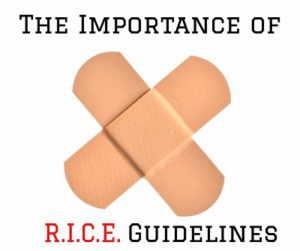 Following an injury, most medical professionals will recommend following the R.I.C.E. guidelines. This stands for Rest, Ice, Compression, and Elevation, and helps your body part to heal so that you can get back to your normal workouts.
Following an injury, most medical professionals will recommend following the R.I.C.E. guidelines. This stands for Rest, Ice, Compression, and Elevation, and helps your body part to heal so that you can get back to your normal workouts.
What Does R.I.C.E. Entail?
As you know, R.I.C.E. stands for rest, ice, compression, and elevation. These are the basic components of first aid when you have a sprain, strain, or other similar injury. Here is a breakdown of each part of the RICE treatment plan:
Rest – You first want to make sure you get plenty of rest following an injury. Don’t put weight on a foot if you just sprained your ankle, and be careful about lifting heavy objects if you just threw out your back. Getting rest is one of the most important treatments for an injury.
Ice – Next is icing the area, which is good for reducing swelling and inflammation of the joint. This is where a lot of the pain comes from, so you will notice intermittent icing helps to reduce the pain as well. Just make sure the ice or ice pack is not applied directly to the skin; cover it in a thin towel first.
Compression – Compression means to wrap the area to keep it supported and free from further injury. You can either wrap it yourself, such as with an Ace bandage, or go to urgent care to get it wrapped by a medical professional.
Elevation – Lastly, you will need to elevate the extremity where you got the injury. You usually need it elevated above the level of your heart, which reduces pain and helps to reduce the swelling.
How it is Helpful for an Injury?
When you follow these steps, you are helping to reduce the pain and more importantly, reduce the swelling. That swelling causes inflammation of the joint, which is only going to make it more painful. R.I.C.E. can also help to speed up the healing process and reduce permanent tissue damage to the joints involved in the injury.
This should only be looked at as a short-term treatment plan for the first few days after an injury. If you still have swelling after 72 hours, you need to go to a doctor and get x- rays done. It is possible that the injury is more severe than you anticipated. In this case, they might need to perform surgery or provide another medical treatment.






